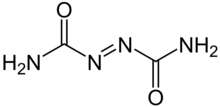This is an old revision of this page, as edited by Beetstra (talk | contribs) at 08:27, 18 January 2011 (Script assisted update of identifiers from ChemSpider, CommonChemistry and FDA for the Chem/Drugbox validation project - Updated: ChEMBL.). The present address (URL) is a permanent link to this revision, which may differ significantly from the current revision.
Revision as of 08:27, 18 January 2011 by Beetstra (talk | contribs) (Script assisted update of identifiers from ChemSpider, CommonChemistry and FDA for the Chem/Drugbox validation project - Updated: ChEMBL.)(diff) ← Previous revision | Latest revision (diff) | Newer revision → (diff) | |
| Names | |
|---|---|
| IUPAC name Carbamoyliminourea | |
| Other names
Azodicarobxamide Azobisformamide C,C'-azodi(formamide) | |
| Identifiers | |
| CAS Number | |
| 3D model (JSmol) | |
| ChEMBL | |
| ChemSpider | |
| ECHA InfoCard | 100.004.229 |
| E number | E927a (glazing agents, ...) |
| PubChem CID | |
| UNII | |
| CompTox Dashboard (EPA) | |
InChI
| |
SMILES
| |
| Properties | |
| Chemical formula | C2H4N4O2 |
| Molar mass | 116.080 g·mol |
| Appearance | Yellow to orange/red crystalline powder |
| Hazards | |
| NFPA 704 (fire diamond) |
 |
| Except where otherwise noted, data are given for materials in their standard state (at 25 °C , 100 kPa).
| |
Azodicarbonamide, or azobisformamide, is an synthetic chemical with the molecular formula C2H4O2N4. It is a yellow to orange red, odorless, crystalline powder. As a food additive, it is known by the E number E927.
Use as a food additive
Azodicarbonamide is used in food industry as a food additive, a flour bleaching agent and improving agent. It reacts with moist flour as an oxidizing agent. The main reaction product is biurea (not urea), which is stable during baking. Secondary reaction products include semicarbazide and ethyl carbamate.
The United States allows azodicarbonamide to be added to flour at levels up to 45 ppm. Use of azodicarbonamide as a food additive is banned in Australia and in Europe. In Singapore, the use of azodicarbonamide can result in up to 15 years imprisonment and a fine of $450,000.
Other uses
The principal use of azodicarbonamide is in the production of foamed plastics as an additive. The thermal decomposition of azodicarbonamide results in the evolution of nitrogen, carbon monoxide, carbon dioxide, and ammonia gases, which are trapped in the polymer as bubbles to form a foamed article. Common examples of this application are window and door gaskets, padded floor mats, gym/exercise mats, shoe soles, etc.
It is important to mention that azodicarbonamide in the use of plastics, synthetic leather and other uses can be pure or modified. This is important because modification affects the reaction temperatures. Pure azodicarbonamide generally reacts around 200 degrees C, but there are some products that the reaction temperature must be lower, depending on the application. In the plastic, leather and other industries, modified azodiarbonamide (average decomposition temperature 170 degrees C) contain additives that accelerate the reaction or react at lower temperatures.
Safety
In the UK, the Health and Safety Executive has identified azodicarbonamide as a respiratory sensitizer (a possible cause of asthma) and determined that products should be labeled with "May cause sensitisation by inhalation."
Azodicarbonamide may cause an allergic reaction in those sensitive to other azo compounds, such as food dyes. The consumption of azodicarbonamide may also heighten an allergic reaction to other ingredients in a food.
In connection with food safety, it has wrongly been claimed that azodicarbonamide is completely decomposed into common substances during baking, either into urea or (alternatively) into gases (carbon dioxide, carbon monoxide, nitrogen, and ammonia). Toxicological studies of the reactions of azodicarbonamide show that it is rapidly converted to biurea in dough, which is a stable compound not decomposed upon cooking.
See also
References
- "Azodicarbonamide (CICADS)". Inchem. International Programme on Chemical Safety. Retrieved 2010-08-14.
- "Azodicarbonamide FCC Grade (98%)". Garuda International, Inc. 2009-02-13. Retrieved 2010-08-14.
- Joiner, Robert; Marks, Henry (1963). "A New Powdered Agent for Flour Maturing" (PDF). Cereal Chemistry. 40: 539–553.
{{cite journal}}:|first2=missing|last2=(help); Unknown parameter|DUPLICATE DATA: last=ignored (help); Unknown parameter|month=ignored (help) - Becalski A, Lau BP, Lewis D, Seaman SW (2004-09-10). "Semicarbazide formation in azodicarbonamide-treated flour: a model study". Journal of agricultural and food chemistry. 52 (18). Journal of Agricultural and Food Chemistry: 5730–4. doi:10.1021/jf0495385. PMID 15373416.
{{cite journal}}: CS1 maint: multiple names: authors list (link) - Cañas, BJ; Diachenko, GW; Nyman, PJ (1997). "Ethyl carbamate levels resulting from azodicarbonamide use in bread". Food Additives & Contaminants. 14 (1): 89–94. doi:10.1080/02652039709374501. PMID 9059587.
{{cite journal}}: Unknown parameter|doi_brokendate=ignored (|doi-broken-date=suggested) (help); Unknown parameter|month=ignored (help) - "CFR - Code of Federal Regulations Title 21". United States Department of Health and Human Services. 2009-04-01. Retrieved 2010-08-14.
- "Substances causing/worsening asthma". UK Occupational Health and Safety. WorkSafe Victoria. Retrieved 2010-08-14.
- "054. Azodicarbonamide (FAO Nutrition Meetings Report Series 40abc)". FAO/WHO. 1966-10-18. Retrieved 2010-08-14.
| E numbers | |
|---|---|
|